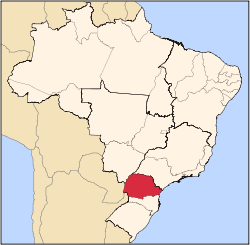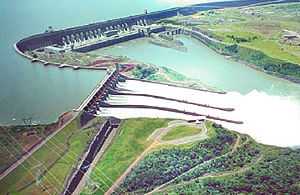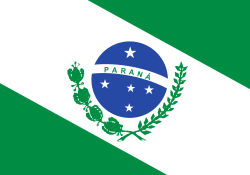Paraná (state)
| State of Paraná | |||
|---|---|---|---|
| State | |||
| |||
| Anthem: Hino do Paraná | |||
 Location of State of Paraná in Brazil | |||
| Coordinates: 24°0′S 51°0′W / 24.000°S 51.000°WCoordinates: 24°0′S 51°0′W / 24.000°S 51.000°W | |||
| Country |
| ||
| Capital and Largest City | Curitiba | ||
| Government | |||
| • Governor | Beto Richa PSDB | ||
| • Vice Governor | Cida Borghetti (PROS) | ||
| Area | |||
| • Total | 199,314.9 km2 (76,955.9 sq mi) | ||
| Area rank | 15th | ||
| Population (2013)[1] | |||
| • Total | 10,997,462 | ||
| • Rank | 6th | ||
| • Density | 55/km2 (140/sq mi) | ||
| Demonym | Paranaense | ||
| GDP | |||
| • Year | 2012 estimate | ||
| • Total | R$ 255,927,000,000 (5th) | ||
| • Per capita | R$ 24,195 (7th) | ||
| HDI | |||
| • Year | 2010 | ||
| • Category | 0.749 - high (5th) | ||
| Time zone | BRT (UTC-3) | ||
| • Summer (DST) | BRST (UTC-2) | ||
| Postal Code | 80000-000 to 86990-000 | ||
| ISO 3166 code | BR-PR | ||
| Website | pr.gov.br | ||
Paraná (Portuguese pronunciation: [paɾaˈna][2]) is one of the 26 states of Brazil, located in the south of the country, bordered on the north by São Paulo state, on the east by the Atlantic Ocean, on the south by Santa Catarina state and the Misiones Province of Argentina, and on the west by Mato Grosso do Sul and the republic of Paraguay, with the Paraná River as its western boundary line.
Cut by the Tropic of Capricorn, Paraná has what is left of the araucaria forest, one of the most important subtropical forests in the world. At the border with Argentina is the National Park of Iguaçu, considered by UNESCO as a World Heritage site. At only 40 km (25 mi) from there, at the border with Paraguay, the largest dam in the world was built, the Hidroelétrica de Itaipu (Itaipu Hydroelectric Dam).
History
Colonisation of the state by settlers started in the 16th century, but was mainly confined to the coasts. In the 1940s, the northern part of the state was settled as a result of the expansion of the São Paulo coffee industry. The south-eastern part of the state was settled as a result of migration from Rio Grande do Sul.[3]
By the early 20th century, the state had two railway systems: the Paranaguá to Curitiba (69 mi, 111 km) with an extension to Ponta Grossa (118 mi, 190 km) and branches to Rio Negro (55 mi, 89 km), Porto Amazonas (6 mi, 10 km) and Antonina (10 mi, 16 km); and the São Paulo and Rio Grande, which crosses the state from northeast to southwest from União da Vitória, on the Iguaçu, to a junction with the Sorocabana line of São Paulo at Itararé. The junction of the two systems was at Ponta Grossa, northwest of Curitiba.
Geography
Paraná is bounded on the north by São Paulo state, on the east by the Atlantic Ocean, on the south by Santa Catarina state and the Misiones Province of Argentina, and on the west by Mato Grosso do Sul and the republic of Paraguay, with the Paraná River as its western boundary line.
The state can be separated into five main topographic areas, from east to west: a coastal zone, the mountains of Serra do Mar, and then three plateaus, each lower than the other, until the Paraná River is reached.[4]
The largest rivers in the state are the Paranapanema and its tributaries the Cinza and Tibaji, the Ivaí, Piquiri, Jejuy-guassu, and the Iguaçu with its principal tributary the Rio Negro. The Paranapanema and a small tributary, the Itarare', form the boundary line with São Paulo west of the Serra do Mar, and the Iguaçu and Negro, the boundary line with Santa Catarina and Argentina - both streams having their sources in the Serra do Mar and flowing westward to the Paraná. The other streams have shorter courses, and all are obstructed by falls and rapids. Twenty miles above the mouth of the Iguaçu are the Iguaçu Falls, 215 ft (66 m) high, broken into 20 or more falls separated by rocks and islands, and surrounded by a wild, unsettled and wooded country. The surface of the plateau is undulating and the greater part is adapted to agricultural and pastoral purposes.
Demographics
According to the IBGE, as of 2010, the state population was 10,439,601. The population density was 51.48/km2 (133.3/sq mi). The population of Curitiba's metropolitan area was 3,168,980. Urbanization in the state was: 84.5% (2006), population growth was 1.4% (1991–2000), and houses numbered 3,177,000 (2006).[5]
The 2005 IBGE survey gave the following breakdown by race for the state: White (Branca) (73.0%), Pardos (multiracial) (23.3%), Black (Preta) (2.5%), and Amerindian (1.2%).[6]
Parana's population is primarily of Eastern European origin, but Germans, Portuguese, and Japanese also settled in the state.[7] A variation of German known as Paraná-Wolga-Deutsch originated in the area.[8]

A genetic study found the ancestry of the average "White" person in Paraná is 80.6% European, 12.5% Black African, and 7.0% Amerindian. The average "Mulatto" is 49.5% Black African, 41.8% European, and 8.7% Amerindian.[9] However, another study has concluded European ancestry is dominant throughout Brazil at 80%, except for the southern part of Brazil, where the European heritage reaches 90% (Paraná included, all of the Paraná population, "whites", "pardos", and "blacks"). "A new portrayal of each ethnicity contribution to the DNA of Brazilians, obtained with samples from the five regions of the country, has indicated that, on average, European ancestors are responsible for nearly 80% of the genetic heritage of the population. The variation between the regions is small, with the possible exception of the South, where the European contribution reaches nearly 90%. The results, published by the scientific magazine American Journal of Human Biology by a team of the Catholic University of Brasília, show, in Brazil, physical indicators such as skin, eye, and hair colour have little to do with the genetic ancestry of each person, which has been shown in previous studies.[10]
Initially settled by the Guarani and Kaingang Amerindians, until the 17th century, virtually no European presence existed in Paraná. The number of settlers grew around 1750 and the population was composed of Amerindians, Portuguese, and some Spaniards. African slaves from Angola and Mozambique were also present, but in fewer numbers than in other Brazilian areas, because Paraná was a poor region that did not need much slave manpower. Immigration grew in the mid-19th century, mostly composed of Italian, German, Polish, Ukrainian, and Japanese peoples. While Poles and Ukrainians are present in Paraná, their presence in the rest of Brazil is almost nil. In the early 20th century, two waves of migration to Paraná occurred: one coming from the north, mostly of Portuguese, but also of African and Amerindian origin, and another from southern Brazil to the southwest and west, mostly of Portuguese, Italian, and German origins.[11]
Largest cities
| | |||||||||
|---|---|---|---|---|---|---|---|---|---|
| Rank | Mesoregion | Pop. | Rank | Mesoregion | Pop. | ||||
 Curitiba  Londrina |
1 | Curitiba | Metropolitana de Curitiba | 1.764.540 | 11 | Apucarana | Norte Central | 121.924 | |
| 2 | Londrina | Norte Central | 511.278 | 12 | Araucária | Metropolitana de Curitiba | 121.032 | ||
| 3 | Maringá | Norte Central | 362.329 | 13 | Toledo | Oeste | 120.934 | ||
| 4 | Ponta Grossa | Centro Oriental | 318.527 | 14 | Pinhais | Metropolitana de Curitiba | 118.084 | ||
| 5 | Cascavel | Oeste | 289.339 | 15 | Campo Largo | Metropolitana de Curitiba | 113.881 | ||
| 6 | São José dos Pinhais | Metropolitana de Curitiba | 268.807 | 16 | Arapongas | Norte Central | 105.587 | ||
| 7 | Foz do Iguaçu | Oeste | 255.900 | 17 | Almirante Tamandaré | Metropolitana de Curitiba | 104.350 | ||
| 8 | Colombo | Metropolitana de Curitiba | 215.242 | 18 | Umuarama | Noroeste | 101.442 | ||
| 9 | Guarapuava | Centro-Sul | 168.262 | 19 | Cambé | Norte Central | 97.389 | ||
| 10 | Paranaguá | Metropolitana de Curitiba | 141.477 | 20 | Piraquara | Metropolitana de Curitiba | 94.767 | ||
Economy
Since the 1950s, Paraná has been one of Brazil's agriculture powerhouses. The state started out as a major producer of coffee, which dominated the state's agriculture, particularly in the highly cultivated northern part of the state.
The state industry was originally based on agrobusiness: meat, coffee, dairy, lumber, tea, and chicken processing. Still today they are responsible for a large part of the industrial production.
The 1970s inauguration of the Volvo Factory in Curitiba began a car manufacturing industry. Plants of several different brands and industries are located around metropolitan Curitiba, producing around 450.000 cars, buses, and trucks a year.
The industry today is very diversified; the Curitiba Metropolitan Area has a whole range of industries including computers, freezers and cosmetics. There are also several industries around the main cities, in particular Ponta Grossa (Soybean products), Londrina (Coffee and Cattle), Maringá (Soybeans and Cattle), Telemaco Borba (Lumber and Cellulose) and Cianorte (Textiles and Clothing).
Paraná's per capita GDP in 2005 was R$12,339, or US$5,400, eighth in Brazil and comparable to that of Turkey.[13]
Statistics
- Vehicles: 3,808,298 (March 2007)
- Mobile phones: 12 million (August 2011)
- Telephones: 2.7 million (April 2007)
- Cities: 399 (2007)[14]
Education

Educational institutions
Federal universities:
- Universidade Federal do Paraná (UFPR) (Federal University of Paraná)
- Universidade Tecnológica Federal do Paraná (UTFPR) (Federal Technological University of Paraná)
- Instituto Federal de Educação, Ciência e Tecnologia do Paraná (IFPR) (Paraná Federal Institute of Education, Science and Technology)
Infrastructure

International airports
Afonso Pena International Airport is Curitiba's main airport. It is located in the nearby city of São José dos Pinhais and all commercial flights operate from this airport.
Foz do Iguaçu International Airport. Brazil's main airlines serve the city daily, connecting it with the rest of the country and foreign cities. Regional routes also serve local traffic.
Social care
Paraná has one of the highest standards of living in Brazil, with relatively low crime levels, a special attention given to education and health, and a HDI of about 0.820, the fifth-highest in Brazil.
Sports
Two of the biggest football sides in the state are Clube Atlético Paranaense and Coritiba Foot Ball Club, who play the Atletiba derby.[15]
Curitiba is one of the 12 host cities of the 2014 FIFA World Cup.
Album
-

Pico Paraná
-

Art Museum designed by Oscar Niemeyer
-

Itaipu dam
-
Vila Velha stone formation
-

Bus station in Curitiba
-

Stairway to the Ilha do Mel lighthouse
-
Brejatuba beach
See also
References
- ↑ "POPULAÇÃO RESIDENTE, EM 1o DE ABRIL DE 2007, SEGUNDO AS UNIDADES DA FEDERAÇÃO" (PDF) (in Portuguese). IBGE. Retrieved 21 April 2013.
- ↑ In Brazilian Portuguese. The European Portuguese pronunciation is [pɐɾɐˈna].
- ↑ "Supporting the Contribution of HEIs to Regional Development" (PDF). Secretariat of Science, Technology and Higher Education, State of Parana. Retrieved 21 April 2013.
- ↑ "Paraná". Encyclopaedia Britannica. Retrieved 6 January 2013.
- ↑ Source: PNAD.
- ↑ "Tabela 9.1 - População total e respectiva distribuição percentual, por cor ou raça, segundo as Grandes Regiões, Unidades da Federação e Regiões Metropolitanas - 2005" (PDF). Síntese de indicadores sociais 2006 (in Portuguese). IBGE. p. 248. Retrieved 21 April 2013.
- ↑ Higher Education in Regional and City Development: State of Paraná, Brazil (PDF). OECD. 2011. p. 38. ISBN 978-92-64-089020.
- ↑ http://web.archive.org/web/20051231112918/http://www.linguasphere.org/auswanderungs_deutsch.pdf
- ↑ HLA polymorphism and evaluation of European, African, and Amerindian contribution to the white and mulatto populations from Parana, Brazil
- ↑ http://www1.folha.uol.com.br/folha/ciencia/ult306u633465.shtml
- ↑ HLA polymorphism and evaluation of European, African, and Amerindian contribution to the white and mulatto populations from Parana, Brazil
- ↑ "ESTIMATIVAS DA POPULAÇÃO RESIDENTE NOS MUNICÍPIOS BRASILEIROS COM DATA DE REFERÊNCIA EM 1º DE JULHO DE 2011" (PDF) (in Portuguese). Instituto Brasileiro de Geografia e Estatística. 30 August 2011. Archived from the original (PDF) on 31 August 2011. Retrieved 31 August 2011.
- ↑
- IBGE (November 2007). "Regional Accounts 2005" (in Portuguese). Retrieved 2007-11-26.
- ↑ Source: IBGE.
- ↑ "Atlético-PR VS Coritiba: Atletiba, the rivalry that went national". Rivalries. FIFA. Retrieved 17 August 2014.
![]() This article incorporates text from a publication now in the public domain: Chisholm, Hugh, ed. (1911). Encyclopædia Britannica (11th ed.). Cambridge University Press.
This article incorporates text from a publication now in the public domain: Chisholm, Hugh, ed. (1911). Encyclopædia Britannica (11th ed.). Cambridge University Press.
External links
- (Portuguese) Official Website
- Brazilian Tourism Portal
- (Portuguese) Official Hotel Guide
| ||||||||||||||||||||||||||||||||||||||
| ||||||||||||||||||||||||||||||||||||||||||||||||||||||||||||||||||||||||||||||||
| ||||||||||||||||||||||||||





